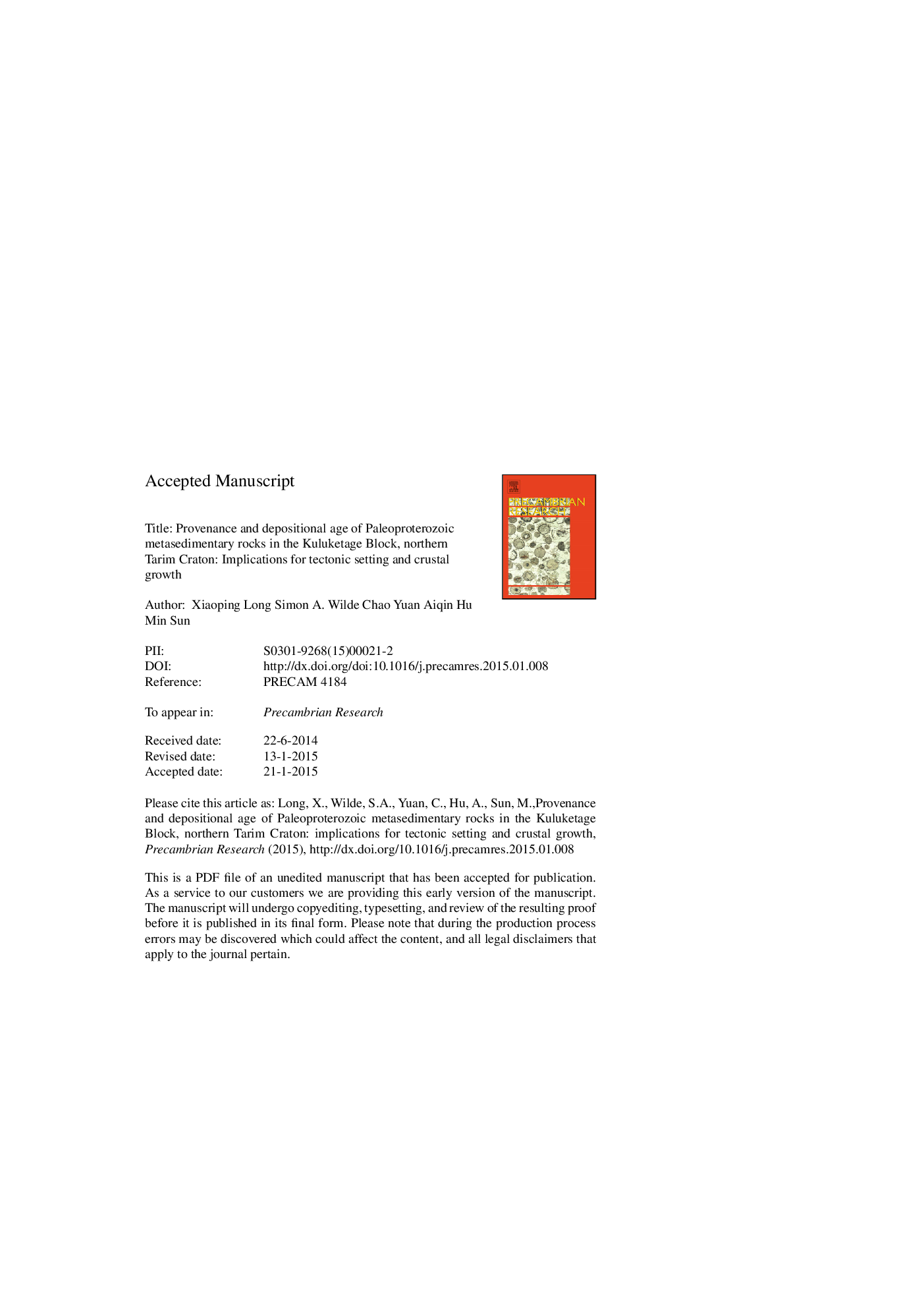| کد مقاله | کد نشریه | سال انتشار | مقاله انگلیسی | نسخه تمام متن |
|---|---|---|---|---|
| 6442258 | 1639615 | 2015 | 59 صفحه PDF | دانلود رایگان |
عنوان انگلیسی مقاله ISI
Provenance and depositional age of Paleoproterozoic metasedimentary rocks in the Kuluketage Block, northern Tarim Craton: Implications for tectonic setting and crustal growth
دانلود مقاله + سفارش ترجمه
دانلود مقاله ISI انگلیسی
رایگان برای ایرانیان
کلمات کلیدی
موضوعات مرتبط
مهندسی و علوم پایه
علوم زمین و سیارات
ژئوشیمی و پترولوژی
پیش نمایش صفحه اول مقاله

چکیده انگلیسی
Precambrian geology of the Tarim Craton, especially for the crustal evolution, is poorly constrained. Paleoproterozoic metasedimentary rocks are extensively exposed in the Kuluketage Block, northern Tarim Craton, and thus have recorded abundant geological information of its tectonic history. Supracrustal rocks within the Archean basement (Tuoge Complex) and the Paleoproterozoic Xingditage Group were collected from the Kuluketage Block for geochemical study and zircon U-Pb dating. The Tuoge supracrustal rocks have low CIA values between 45 and 63, indicating weak chemical weathering. Although the Xingditage Group shows a large variation of CIA values (37-67), their low average value suggests that they underwent similar weathering to the rocks from the basement. This similarity is also supported by their respective PIA values (mostly 43-57 for the basement rocks, and mostly 37-60 for the Xingditage Group). The high ICV values (mostly >1) of both rock suites indicate an immature source that lacked alumina-rich minerals. Although these metasedimentary rocks show different REE patterns, they are all enriched in light rare earth element (LREE) and display relatively flat heavy rare earth element (HREE) patterns. The low values of ferromagnesian (e.g. Cr, Co and Ni) and high field strength elements (e.g. Zr, Hf, Nb, Ta and Y) are similar to those of graywackes from active continental margins. Therefore, the Kuluketage Block most likely evolved in an active continental margin setting during the late Paleoproterozoic. Detrital zircons from a slate sample of the Tuoge supracrustal rocks are dominated by igneous zircons, which mostly yield Paleoproterozoic 207Pb/206Pb ages between 1.72 Ga and 2.08 Ga. Other igneous grains give Paleoproterozoic 207Pb/206Pb ages at â¼2.2 Ga and â¼2.32 Ga. All these igneous zircons show large variations of ÉHf(t) values mostly between â17 and â3, and have Neoarchean crustal model ages (TDMc = 2.6-3.7 Ga). Schist and quartzite samples of the upper Xingditage Group show similar age spectra to the slate and contain a major igneous zircon population with Paleoproterozoic formation ages (mostly 1.8-2.1 Ga) and Paleo- to Mesoarchean TDMc ages (2.7-3.1 Ga). A schist sample of the lower Xingditage Group shows a much different age spectrum. Detrital zircons from this sample are dominated by Neoarchean grains (2.5-2.7 Ga) with Paleoarchean TDMc ages (3.14-3.51 Ga) and two of them yield the youngest ages at 1.94 and 2.09 Ga. The youngest zircons from these samples, therefore, define the maximum depositional ages at 1.63, 1.94 and 1.77 Ga for the Tuoge supracrustal rocks, the upper Xingditage Group and the lower Xingditage Group, respectively. On basis of these age spectra, we suggest that the Tuoge supracrustal rocks are equivalents of the upper Xingditage Group, instead of parts of the Archean basement. Overall, the Hf isotopic compositions of these detrital zircons indicate three early Precambrian crustal growth events in the Tarim Craton, which occurred in the late Paleoarchean, the early Neoarchean and at the beginning of the Paleoproterozoic.
ناشر
Database: Elsevier - ScienceDirect (ساینس دایرکت)
Journal: Precambrian Research - Volume 260, May 2015, Pages 76-90
Journal: Precambrian Research - Volume 260, May 2015, Pages 76-90
نویسندگان
Xiaoping Long, Simon A. Wilde, Chao Yuan, Aiqin Hu, Min Sun,